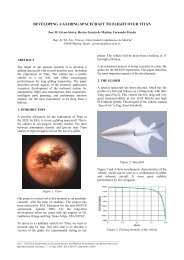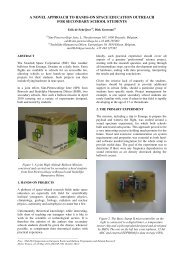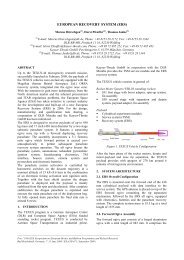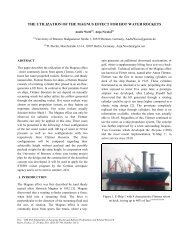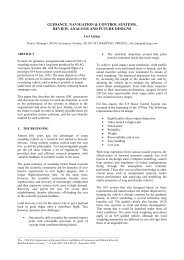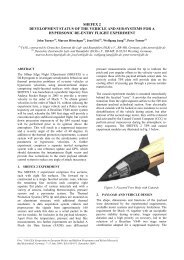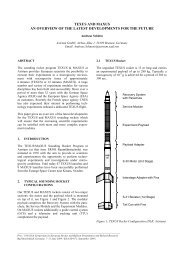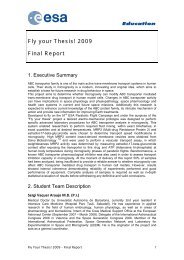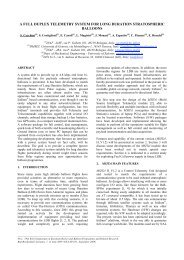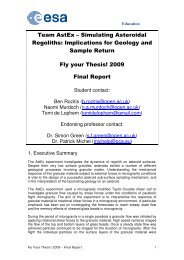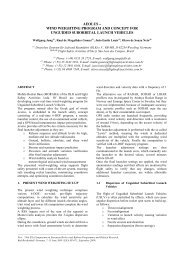sounding rocket trajectory simulation and optimization with astos - ESA
sounding rocket trajectory simulation and optimization with astos - ESA
sounding rocket trajectory simulation and optimization with astos - ESA
You also want an ePaper? Increase the reach of your titles
YUMPU automatically turns print PDFs into web optimized ePapers that Google loves.
SOUNDING ROCKET TRAJECTORY SIMULATION AND OPTIMIZATION WITH<br />
ASTOS<br />
Francesco Cremaschi (1) , Sven Weikert (2) , Andreas Wieg<strong>and</strong> (3) , Wolfgang Jung (4) , Frank Scheuerpflug (5)<br />
ABSTRACT<br />
(1) Astos Solutions GmbH, Germany, Tel: +49-711-6723561-14, Email: francesco.cremaschi@<strong>astos</strong>.de<br />
(2) Astos Solutions GmbH, Germany, Tel: +49-711-6723561-12, Email: sven.weikert@<strong>astos</strong>.de<br />
(3) Astos Solutions GmbH, Germany, Tel: +49-7721-50142, Email: <strong>and</strong>reas.wieg<strong>and</strong>@<strong>astos</strong>.de<br />
(4) DLR, Germany, Tel.: +49-8153-28-2724/2606, Email: wolfgang.jung@dlr.de<br />
(5) DLR, Germany, Tel.: +49-8153-28-2724/2606, Email: frank.scheuerpflug@dlr.de<br />
With a long experience in the <strong>simulation</strong> <strong>and</strong><br />
<strong>optimization</strong> of atmospheric trajectories (launcher <strong>and</strong><br />
re-entry vehicles), ASTOS [1], the AeroSpace<br />
Trajectory Optimization Software, has been applied to<br />
the <strong>sounding</strong> <strong>rocket</strong> environment. An extensive library<br />
[2] of differential equations (3-DOF <strong>and</strong> 6-DOF),<br />
vehicle models (propulsion, aerodynamics, etc.),<br />
constraints <strong>and</strong> cost functions is available to the user, in<br />
a friendly graphical user interface (GUI).<br />
As a demonstration test-case, the <strong>simulation</strong> of the<br />
SHEFEX II (SHarp Edge Flight EXperiment) mission is<br />
presented. In collaboration <strong>with</strong> DLR MORABA<br />
(Mobile Rocket Base), the available aerodynamics <strong>and</strong><br />
propulsion data has been inserted in ASTOS to<br />
reproduce (through <strong>simulation</strong>) <strong>and</strong> improve (through<br />
<strong>optimization</strong>) the <strong>trajectory</strong>. Furthermore the paper<br />
depicts the post-processing features of the software: the<br />
results can be displayed both numerically <strong>and</strong><br />
graphically, the first for a precise evaluation of the<br />
<strong>trajectory</strong> data <strong>and</strong> the latter to provide a straightforward<br />
overview of the mission. Safety aspects are covered by a<br />
dispersion analysis of the impact position that completes<br />
the paper.<br />
1. ASTOS SOFTWARE TOOL<br />
ASTOS is a <strong>simulation</strong> <strong>and</strong> <strong>optimization</strong> environment to<br />
simulate <strong>and</strong> optimize trajectories for a variety of<br />
complex, multi-phase optimal control problems. In the<br />
last twenty years it has been successfully applied in<br />
several industrial or <strong>ESA</strong> projects in the field of<br />
launcher, re-entry <strong>and</strong> exploration missions. Just to<br />
provide some examples: Ariane5, Vega, ATV, Hopper,<br />
Skylon, Fly-back Booster, X38, Capree, ATPE, USV,<br />
Smart-Olev, LEO, Astex, IXV, ARD, Expert, et. al.<br />
ASTOS consists of fast <strong>and</strong> powerful <strong>optimization</strong><br />
programs, PROMIS, CAMTOS, SOCS <strong>and</strong> TROPIC,<br />
that h<strong>and</strong>le large <strong>and</strong> highly discretised problems, a user<br />
interface <strong>with</strong> multiple-plot capability <strong>and</strong> an integrated<br />
graphical iteration monitor to review the <strong>optimization</strong><br />
process <strong>and</strong> plot the state <strong>and</strong> control histories at<br />
intermediate steps during the <strong>optimization</strong>.<br />
ASTOS comprises an extensive model library, which<br />
allows launcher <strong>and</strong> re-entry <strong>trajectory</strong> <strong>optimization</strong><br />
<strong>with</strong>out programming work.<br />
Figure 1. ASTOS multi screenshot<br />
1.1. Batch Mode capability<br />
___________________________________________________________________________________<br />
Proc. ‘19th <strong>ESA</strong> Symposium on European Rocket <strong>and</strong> Balloon Programmes <strong>and</strong> Related Research,<br />
Bad Reichenhall, Germany, 7–11 June 2009 (<strong>ESA</strong> SP-671, September 2009)<br />
The “Batch Mode Inspector” (since ASTOS version 6.0)<br />
enables the user to perform Monte Carlo analyses<br />
<strong>with</strong>out third-party tools <strong>and</strong> to plot the results directly<br />
by means of ASTOS plotting capabilities. The user can<br />
associate a batch variable to each model uncertainty.<br />
Then, in the Batch Mode Inspector, he can build the<br />
structure of the processes <strong>with</strong> which the batch variables<br />
are used in order to run the model automatically over a<br />
given parameter space. The structure consists of various<br />
batch elements freely chosen by the user. These can be<br />
actions like Initialize, Simulate, Optimize or postprocessing<br />
elements that prepare the data taken from the<br />
<strong>simulation</strong> for further analysis.<br />
The batch variables may be modified by Loop <strong>and</strong><br />
R<strong>and</strong>om elements. Loop will change a batch variable<br />
monotonously from an initial value to a final one using<br />
a given increment. Instead, <strong>with</strong> the R<strong>and</strong>om element it<br />
is possible to compute r<strong>and</strong>om numbers <strong>with</strong> Gaussian<br />
or uniform distribution. Uniform distribution variables<br />
are defined by a lower <strong>and</strong> upper bound, Gaussian by
their mean value <strong>and</strong> the st<strong>and</strong>ard deviation. Further<br />
details are described in [1].<br />
2. SHEFEX<br />
Figure 2. Batch mode inspector<br />
The Sharp Edge Flight Experiment is a DLR (German<br />
Aerospace Centre) program to investigate aerodynamic<br />
behaviour <strong>and</strong> thermal protection problems <strong>and</strong> develop<br />
solutions for re-entry vehicles at hypersonic velocities,<br />
using unconventional shapes comprising multi-facetted<br />
surfaces <strong>with</strong> sharp edges. Sounding <strong>rocket</strong>s provide a<br />
useful facility to obtain experimental flight data for<br />
period of several orders greater than possible <strong>with</strong> shock<br />
tunnels. The first SHEFEX <strong>sounding</strong> <strong>rocket</strong> launch,<br />
comprising an experiment <strong>with</strong> an asymmetric form at<br />
re-entry velocities of Mach 6-7, was launched from the<br />
Andoya Rocket Range (ARR), Norway, in October<br />
2005. The success of this mission led to the definition<br />
<strong>and</strong> approval of the SHEFEX 2 mission.<br />
Figure 3. Artistic impression of SHEFEX2<br />
SHEFEX 2 was originally conceived as a payload <strong>with</strong><br />
small passive stabilizing fins, to be flown on a VSB-30<br />
<strong>with</strong> a conventional parabolic <strong>trajectory</strong> which would<br />
have provided velocities in the order of Mach 8. The<br />
greater velocity, together <strong>with</strong> a re-entry elevation angle<br />
in the order of 75 degrees, would have resulted in a<br />
short experiment time. An alternative solution was then<br />
found in the VS-40 motor combination together <strong>with</strong> a<br />
precession control of the spinning second stage to<br />
provide a conventional <strong>trajectory</strong> of the first stage<br />
together <strong>with</strong> a suppressed <strong>trajectory</strong> of the exoatmospheric<br />
burning second stage. The result is a flatter<br />
re-entry angle of about 35 degrees <strong>and</strong> a velocity of<br />
Mach 10, which still provides in the order of 60 seconds<br />
of experiment time between 100 <strong>and</strong> 20 kilometres<br />
altitude.<br />
The results are a vehicle <strong>and</strong> a payload that are the most<br />
complex <strong>and</strong> challenging projects MORABA has<br />
constructed <strong>and</strong> launched to date.<br />
3. TRAJECTORY SIMULATION<br />
As described in section 2, the SHEFEX 2 mission will<br />
be launched by a two stage <strong>sounding</strong> <strong>rocket</strong>. The<br />
workflow to simulate a <strong>trajectory</strong> in ASTOS is intuitive<br />
<strong>and</strong> in line <strong>with</strong> the logic of the mission design<br />
engineer. The first steps are performed in the Model<br />
Browser, the GUI that links all the models of the<br />
ASTOS library.<br />
3.1. Modelling the Vehicle<br />
- Define the environment either from a list of already<br />
available models or linking external data from txt or<br />
Excel files<br />
- Define the vehicle components: stages <strong>with</strong><br />
structural <strong>and</strong> propellant mass, payload, fairing, etc.<br />
- Define the propulsion systems: thrust, mass-flow or<br />
Isp profile; jet damping<br />
- Define the aerodynamic models used in the course<br />
of the mission through coefficient <strong>and</strong> inertia tables<br />
- Define the list of phases based on the thrust <strong>and</strong><br />
coast arcs<br />
Figure 4. SHEFEX case in Model Browser<br />
The most important task of the model definition is the<br />
phase list: it is required to define a new phase every<br />
time a “discontinuity” is present in the physical vehicle.<br />
A discontinuity could be a new aerodynamic<br />
configuration, the jettisoning of a module or an<br />
important point of the mission. In the specific case of<br />
the SHEFEX 2 missions:<br />
- Starting the engine <strong>with</strong> the vehicle still fixed at the<br />
ramp.<br />
- The vehicle is moving along the inclined rail due to<br />
the thrust force.<br />
- Thrust arc of the first stage until burn-out.<br />
- Coast arc until the separation of the first stage.<br />
- Coast arc until the ignition of the second stage,<br />
required to compute the re-pointing manoeuvre.
- Re-pointing manoeuvre to produce a suppressed<br />
<strong>trajectory</strong> (see section 2).<br />
- Thrust arc of the second stage till burn-out <strong>and</strong><br />
separation.<br />
- Coast arc until 100 km altitude.<br />
- Experiment phase until 20km altitude.<br />
- Re-entry until ground impact.<br />
3.2. Simulation <strong>and</strong> visualization<br />
As soon as the mission is modelled, the <strong>simulation</strong> can<br />
be easily performed <strong>with</strong> the pressing of a button in the<br />
GUI of ASTOS.<br />
Also the <strong>trajectory</strong> visualization is managed through the<br />
graphical interface: hundreds of auxiliary functions are<br />
automatically computed by ASTOS <strong>and</strong> can be arranged<br />
in the “Viewer” according to the user requirements.<br />
3.3. ASTOS computation verification<br />
ASTOS has been extensively used for the computation<br />
of launcher <strong>trajectory</strong> where the <strong>simulation</strong> <strong>and</strong><br />
<strong>optimization</strong> of a point mass (3DOF) is accurate enough<br />
in firsts phases of a mission design.<br />
According to this experience, a 3DOF <strong>simulation</strong> has<br />
been performed <strong>and</strong> the results compared <strong>with</strong> a 6DOF<br />
<strong>simulation</strong> (Fig.5).<br />
Figure 5. Comparison 3-6DOF <strong>simulation</strong><br />
The comparison shows that the 3DOF <strong>and</strong> the 6DOF<br />
<strong>simulation</strong>s are quite different: a simple 3DOF<br />
<strong>simulation</strong> seems not accurate enough for this <strong>sounding</strong><br />
<strong>rocket</strong> mission. A second comparison is performed<br />
between the ASTOS <strong>simulation</strong> (6DOF) <strong>and</strong> the<br />
reference <strong>trajectory</strong> computed by MORABA [3].<br />
Figure 6. ASTOS verification<br />
The altitude profile is almost identical (Figure 6).<br />
Several other auxiliary functions have been compared<br />
<strong>and</strong> the matching between the ASTOS computation <strong>and</strong><br />
the MORABA reference <strong>trajectory</strong> is very good. This<br />
result validates the ASTOS 6DOF computation for<br />
<strong>sounding</strong> <strong>rocket</strong> applications.<br />
3.4. Atmosphere effect<br />
An accurate analysis of the ASTOS results (Figure 6)<br />
reveals an important difference in the Mach profile<br />
when the vehicle is flying at high altitude (above 100<br />
km). The Mach number is the ratio between the vehicle<br />
speed <strong>and</strong> the speed of sound; the speed of sound is<br />
computed by the atmosphere model as function of the<br />
altitude. The altitude <strong>and</strong> the vehicle speed profiles are<br />
almost identical between ASTOS <strong>and</strong> the reference tool:<br />
the atmosphere model is the “guilty” party.<br />
Both ASTOS <strong>and</strong> the reference tool are using the US<br />
St<strong>and</strong>ard 62 model [4], but it seems that the<br />
interpretation of this model for high altitudes is not<br />
univocal.<br />
This result directs the attention to the importance of the<br />
atmosphere model for the correct <strong>simulation</strong> of<br />
<strong>sounding</strong> <strong>rocket</strong> trajectories.<br />
The influence of the atmosphere can be estimated by a<br />
comparison between <strong>simulation</strong>s performed <strong>with</strong> the<br />
several models present in the ASTOS library.<br />
Figure 7. Atmosphere influence<br />
The Figure 7 presents the altitude profile zoomed in the<br />
max-apogee area of the <strong>trajectory</strong>. The different<br />
atmosphere models produce a difference in the order of<br />
2-3 km.<br />
4. IMPACT DISPERSION ANALYSIS<br />
In chapter 3.4 the influence of the atmosphere has been<br />
assessed in relation to the altitude profile of the<br />
<strong>trajectory</strong>, but one of the most critical aspects of a<br />
<strong>sounding</strong> <strong>rocket</strong> <strong>simulation</strong> is the computation of the<br />
impact point. This position is required for technical <strong>and</strong><br />
safety issues: among others the placement of a mobile<br />
tracking station, the payload recovery <strong>and</strong> the<br />
verification that the <strong>rocket</strong> will not exit from the impact<br />
area.<br />
The batch mode capability of ASTOS (see chapter 1.1)<br />
can be merged <strong>with</strong> the extensive data available from<br />
the GRAM99 atmospheric model [5] to compute a
dispersion analysis function of the atmosphere<br />
characteristics: density <strong>and</strong> temperature (Figure 8). In<br />
fact the GRAM99 model contains not only information<br />
on the atmosphere functions (density, pressure,<br />
temperature, composition), but also the dispersion of<br />
these functions (i.e. the one sigma value).<br />
Figure 8. Atmospheric dispersion analysis<br />
Having assessed the power <strong>and</strong> flexibility of the batch<br />
mode in this first exercise, a more comprehensive<br />
Monte Carlo analysis has been conducted on a wider<br />
spectrum.<br />
The atmosphere uncertainties are not the only source of<br />
dispersion in the computation of the impact position;<br />
other variables cannot be precisely identified or<br />
measured in a <strong>sounding</strong> <strong>rocket</strong> mission either.<br />
- Launch ramp elevation<br />
- Launch azimuth<br />
- Drag coefficients<br />
- Vehicle mass<br />
- Thrust value<br />
- Thrust misalignment<br />
Based on the experience of MORABA, the dispersion<br />
values for all these variables have been inserted in the<br />
batch mode of ASTOS (Figure 2). A set of <strong>simulation</strong>s<br />
has been performed <strong>and</strong> automatically post-processed to<br />
provide an indication of the impact region <strong>and</strong><br />
extension.<br />
Figure 9. 3D <strong>trajectory</strong> <strong>and</strong> impact positions<br />
The visualization capability of ASTOS can be<br />
appreciated in Figure 9, where the altitude <strong>and</strong> Mach<br />
number information are plotted over a physical map of<br />
the Earth surface. In the field of the safety assessment,<br />
the possibility to use a map of the Earth population<br />
density as a background can be appreciated. This map<br />
was produced <strong>with</strong> the upmost recent data at the present<br />
date from GPWv3 [6].<br />
Figure 10. Impact positions on population map<br />
As post processing analysis ASTOS computes the<br />
distribution profile of the output variables selected by<br />
the user. In Figure 11 the distribution of the <strong>trajectory</strong><br />
range is presented.<br />
Figure 11. Range distribution<br />
The analysis computed shows an asymmetric Gaussian<br />
bell <strong>with</strong> the peak at the nominal value (550km). This<br />
Monte Carlo analysis is based on 10000 <strong>simulation</strong>s; the<br />
computation time on a Pentium 2.4GHz was 20 hours.<br />
5. OPTIMIZATION<br />
ASTOS was designed in 1989 for <strong>trajectory</strong><br />
<strong>optimization</strong>; since then many <strong>simulation</strong> features have<br />
been added to the tool, but the <strong>optimization</strong> field is still<br />
the playground of this software.<br />
Just to clarify one important point:<br />
- For <strong>simulation</strong> the models should be as complex as<br />
possible<br />
- For <strong>optimization</strong> the models should be as complex<br />
as required<br />
The important phase of the mission, from the scientific<br />
point of view, is the hypersonic re-entry of SHEFFEX2.<br />
The <strong>optimization</strong> goal is therefore to maximize the time
the <strong>rocket</strong> stays at an altitude range between 100km <strong>and</strong><br />
20km <strong>with</strong> Mach number higher than 7.<br />
The problem characteristics are summarized in Table 1.<br />
Open parameters Constraints<br />
Initial pitch<br />
Duration of coast arcs<br />
Pitching maneuver<br />
Range<br />
Required time after<br />
jettison of first <strong>and</strong><br />
second stage<br />
Goal: Maximize the experiment duration<br />
Table 1. Optimization summary<br />
The reference <strong>trajectory</strong> has been provided by<br />
MORABA [3], but the mission design of SHEFEX2 is<br />
not concluded yet, so it is probable that the “flying”<br />
<strong>trajectory</strong> will differ from the one presented in this<br />
paper.<br />
5.1. Results<br />
Even if the modifiable parameters are few, the<br />
<strong>optimization</strong> has tailored the <strong>trajectory</strong> to a completely<br />
different altitude profile (Figure 12).<br />
Figure 12. Optimized vs. reference <strong>trajectory</strong><br />
The launch pad elevation is slightly lower (1.5 degree),<br />
the coast arc before the second stage ignition is longer.<br />
These modifications produce a lower apogee <strong>and</strong><br />
increase the flatness of the Mach profile in the<br />
experiment arc (Figure 12).<br />
The optimized <strong>trajectory</strong> allows an experiment time of<br />
86 seconds, it was 69 in the reference <strong>trajectory</strong>.<br />
Figure 13. 3D map plot, optimized vs. reference<br />
Figure 13 presents a 3D visualization of the two<br />
trajectories, the reference <strong>and</strong> the optimized, from a<br />
different point of view (North-West). Even if the<br />
duration of the optimized <strong>trajectory</strong> (the lower one) is<br />
longer (see Figure 12), the range constraint has not been<br />
violated (see Figure 13).<br />
The increased experiment duration presents one evident<br />
side-effect: the maximum Mach number reached<br />
decreases from 9 to 8.<br />
This is a classical situation in the design of a mission: it<br />
is not possible to gain in all the aspects of the <strong>trajectory</strong>.<br />
Of course it would be possible to change the weight of<br />
the cost function <strong>and</strong> to add more constraints in order to<br />
obtain a different result.<br />
This makes the <strong>optimization</strong> an interactive process<br />
where the engineer <strong>and</strong> the computer work together to<br />
reach the best compromise in the mission design.<br />
6. CONCLUSION<br />
ASTOS is a software tool for <strong>trajectory</strong> <strong>simulation</strong> <strong>and</strong><br />
<strong>optimization</strong> completely data driven through GUI.<br />
The <strong>simulation</strong> results are in line <strong>with</strong> the MORABA<br />
reference tool.<br />
The batch mode capability of ASTOS can be used to<br />
perform an interesting impact dispersion analysis.<br />
The optimized <strong>trajectory</strong> can increase the experiment<br />
time by 25% <strong>with</strong>out any violation of the mission<br />
constraints.<br />
The computation time for a <strong>trajectory</strong> <strong>simulation</strong> (less<br />
than 10 seconds) is in line <strong>with</strong> the ground segment<br />
requirements.<br />
REFERENCES<br />
1. Wieg<strong>and</strong>, A. et al. (2008), ASTOS User Manual,<br />
Version 6.0.0, Astos Solutions GmbH,<br />
Unterkirnach, Germany.<br />
2. Wieg<strong>and</strong>, A. et al. (2008), ASTOS Model Library,<br />
Version 6.0.0, Astos Solutions GmbH,<br />
Unterkirnach, Germany.<br />
3. Jung, W. & Scheuerpflug, F. (2009), Private<br />
Conversation <strong>and</strong> emails. DLR MORABA.<br />
4. U.S. St<strong>and</strong>ard Atmosphere, 1962, U.S. Government<br />
Printing Office, Washington, D.C., 1962.<br />
5. Justus, C.G. Global Reference Atmospheric Model-<br />
1999 (GRAM-99), NASA/MSFC, 1999<br />
6. Center for International Earth Science Information<br />
Network (CIESIN), Columbia University; <strong>and</strong><br />
Centro Internacional de Agricultura Tropical<br />
(CIAT). 2005. Gridded Population of the World<br />
Version 3 (GPWv3). Palisades, NY:<br />
Socioeconomic Data <strong>and</strong> Applications Center<br />
(SEDAC), Columbia University.



